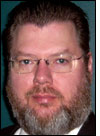Celebration Health, a Florida Hospital facility, is employing a real-time locating system (RTLS) to measure the operational efficiency of its new patient tower, which opened in mid-August 2011. At the tower, nurses wear RTLS badges enabling the hospital to gather and analyze data regarding the movements of staff members, and—based on that information—to ascertain how the unit could be more efficient.
The AeroScout system in use by Celebration Health—a resort-style facility located in the Disney-planned city of the same name—utilizes the hospital’s existing Cisco Wi-Fi infrastructure, with tags that transmit data to the Wi-Fi nodes, while AeroScout MobileView software manages the information related to RTLS reads. Florida Hospital was already using AeroScout tags to track assets and temperatures at some of its 18 statewide facilities (see Florida Hospital Measures Success of Temperature-Tracking System).
The new tower contains 31 patient rooms. The hospital required an RTLS offering room-level granularity, which is not always possible using a Wi-Fi system, since tags IDs can be read from nodes in adjacent rooms. Therefore, AeroScout also installed exciters within each patient room, as well as at some gathering areas and entrances, in order to help identify through which room every individual passes during any given shift, as well as when and how often.
Celebration Health tends to embrace cutting-edge technologies, the company reports, to provide superior patient care focused on overall heath by treating “mind, body and spirit.” The facility is a good site for testing new technologies, according to Todd Frantz, Florida Hospital’s associate chief technology officer, with several such technologies now being tested that he is not yet able to specify or describe.
The hospital’s nursing staff began testing the room-level AeroScout system before the tower was completed, by simply wearing the badges while in their work places, using the existing Wi-Fi network in those areas.
At the new tower, with exciters situated within each of the 31 patient rooms, as well as at the entrances near patient doorways, and at common nurse working areas, the MobileView software can capture data about which rooms were entered and exited, along with when this occurred. All nurses working in the tower wear an AeroScout T2 badge, clipped either to an ID badge, or to a belt. Nurses are discouraged from wearing lanyards, for safety reasons. The active tags transmit data at 2.4 GHz to the Cisco Wi-Fi nodes installed throughout the facility. The exciters serve to more specifically identify the location, by transmitting a low-frequency (LF) 125 kHz signal to trigger the tags as they pass within range of the exciter. Each tag broadcasts its unique identifier, along with that of the exciter, to the Wi-Fi access points.
The badge’s ID number is then sent to the MobileView software, to be interpreted and linked to the location, time and date. Celebration Health will use its own business-management software, including Microsoft Excel spreadsheets, to evaluate the data and determine what it means for staff efficiency, and how it could be improved.
Each badge ID is not linked to a specific employee, Frantz says, noting that the hospital is not interested in tracking data regarding individuals and their movements, though the software is capable of doing so. Instead, the hospital can track each ID number, representing an anonymous nurse, and determine the number of times that he or she walked from one location to the next throughout the 26,400-square-foot unit. This information allows management to view, for example, when employees take extra steps—for instance, a worker may need to go to a storage area on one side of the unit every time he or she visits a patient located in another area, which would indicate that a particular piece of equipment was necessary for specific procedures, and that it should thus be relocated in order to reduce the need for extra steps.
Nurses typically walk many miles during a typical shift, Frantz says, adding, “it’s our hypothesis that they can be more effective if they don’t have to move around as much.” Such analysis, he notes, needs to be weighed against the importance of staying active in order to maintain good health. “We want to determine what motion is useful and valuable, and where do we have motion or activity that reduces our efficiency.”


